Behavioural Effects on Buyer Purchasing Behaviour
| ✅ Paper Type: Free Essay | ✅ Subject: Economics |
| ✅ Wordcount: 2483 words | ✅ Published: 12 Mar 2018 |
EVALUATING BEHAVIORAL FACTORS INFLUENCING CONSUMER’S PURCHASE OF CLOTHING AND ORNAMENTS
Presented by
- Soumita De
- Shivam Sitoke
- Piyushi Chaudhary
- Pratiksha Wadekar
Abstract
This study evaluates behavioral components affecting buyer purchasing conduct of garments and adornments (Jewelry) in Pune, India. It was particularly carried out to analyze customer purchasing decision making process and survey social, financial and in addition individual components affecting purchasing behavior. Information for the study were assembled through structured questionnaire, on a sample of 120 buyers. The purpose behind this exploration is to inspect purchaser’s purchasing conduct and comprehend the key elements of brands which impact shopper’s contribution towards in vogue marked apparel and stylish adornments.
The socio-cultural elements are some of the crucial determinants of an individual’s need and behavior. This paper extends comprehension of customer purchasing behavior identified with Indian environment and highlights the elements that exceedingly impact purchaser association in fashion.
Introduction
In addition to having speedier populace development, India in late decades has made striking financial increases, which have brought about changing societal view of the Indian purchasers. Thus, Indians have turned into a practical ethnic target business sector, Clothing area firms are contending to expand their benefit experience the business and among these organizations; branded attire has moved the traditional dressing enthusiasm of individuals.
The Indian clothing business sector has showed growth and development in a sector described by moderate monetary development. The household clothing business, which was worth INR 207,400 crore (~USD 38 billion) starting 2012, is required to develop at a compound normal growth rate (CAGR) of 9% through the following decade. Further, the late exclusion of extract obligation on marked attire has given a driving force to retailers as far as the general business sector opinion.
Development in Apparel Industry in India is expanding complex with the change in way of life, income and urbanization of the individuals. The overall customers are accepting the clothing style items created in India. AII has understood the tremendous potential to yield business in this section. The Indian purchasers are embracing stylish things rapidly and helpfully with the ascent in rivalry. The present study has been led to determine the data on the patterns of Apparel Industry in India through dissecting the present and future angles.
The gems and Jewelery business is one of the biggest buyer divisions in the nation, bigger than telecom, cars and attire and maybe second just to the nourishment segment. Shoppers are more quality cognizant. The Indian adornments business sector is experiencing a slow transformation from unorganized to organized sector. In a short compass of time, sorted out retailers have effectively actualized a change in the purchasing example of the Indian buyers. This is obvious from the movement from the customary jewelery dealer to the jewelery specialist with a character. This shift obviously demonstrates a change in perspective of adornment as an item to brand Identification.
A paper named ‘Evaluation of Socio-Cultural Factors Influencing Consumer Buying Behaviour of Clothes in Borno State, Nigeria’ by Lawan A. Lawan and Ramat Zanna said that Socio-cultural variables made up of social, monetary, and instrumental variables are key components influencing buyer purchasing behavior, it is in this way presumed that socio-cultural elements, either acting autonomously or in conjunction with other individual or demographic components have huge impacts at every stage (need distinguishment, data pursuit, and assessment, support, and post buy conduct) of the purchaser garments purchasing decision making procedure. Having developed the idea from this paper, we try to test the how various buying behavior influence the consumption of an individual in Pune, India.
A paper by Namrata Anand and Vandana Khetarpal from Haryana- India named “Growth of Apparel industry in India: Present and Future” India alternatively said that the span of both domestic and exports houses of Apparel Industry in India (AII) is anticipated to develop at a CAGR of 9.5% to reach $223 billion by 2021 from the $89 billion in 2011, as indicated by a white paper by industry body FICCI and research firm Technopak. India’s offer of the world’s clothing fares remains at 4.5%. It is evaluated that because of the expanding movement of clothing and material creation to Asian countries and the breaking down fare intensity of China, this figure will develop to 8% by 2020, with an aggregate fares estimation of $82 billion. This development, from 4.5 to 8% of world exchange, will open up immense potential for Indian players.
According to Bureau of Indian Standards (BIS), the survey stated that most gold jewelery publicized in India as 22-carat was of a lesser quality. Over80% of the diamond setters sold gold adornments running from 13.5 carats to 18 carats as22-carat gold gems. The late 1990s saw various marked adornments players entering the Indian market. O ne can watch that there is gigantic extension for the development of marked gems. Despite the financial stoppage specialists accept that it will develop at a CAGR of 25%.
A paper on “Purchasing Behavior of Women towards Ornaments: A Case Study of Bihpuria Town under Lakhimpur district, Assam” which focuses on the purchasing behavior of ornaments by women in Assam and the percentage of money spent on the ornaments from their total income.
Empirical research on the influence of culture on consumer buying behaviour, conducted by Kacea and Lee revealed that there is a compelling and steady impact of society at both ethnicity level and the individual level. The study included that among numerous parts of buyer purchasing conduct which social components moderate incorporate character toward oneself, regularizing impacts, the concealment of feeling, and the post asphalt of moment satisfaction.
Objective of the Study
To study and comprehend the purchasing conduct of shoppers for branded and non-branded jewellery and clothing
The study bails us to discover the contrast between discernment, feeling and conduct of branded and non-branded jewellery and clothing.
This exploration provides for us a thought regarding the parameters, purchaser consider while purchasing garments or adornments and to know the level of information that the buyers have while purchasing.
Methodology
The region of study is the city of Pune, Maharashtra, India. Pune is said to be the social capital of the condition of Maharashtra. It embodies Marathi society, which lays accentuation on training, expressions and artworks, music, and theater. Pune society mirrors a mix of conventions with advancement, alongside facilitating established shows. Organized poll was utilized to inspire reactions on components impacting customer purchasing conduct. The populace for the study involved occupants from distinctive regions in Pune. The exploration utilized just essential wellsprings of information. Information acquired were subjected to illustrative measurements, chi square, T-Statistics and different relapse investigation utilizing a measurable bundle; GRETL and SPSS.
Analysis and Interpretation
The information acquired were investigated through program named Gretl and the outcomes were then interpreted.
In this study as data collection system, questionnaire /survey was preferred to get target information.
Questionnaire has been readied remembering the different human practices and it contained the accompanying questions:
Do you like shopping around?
 Yes
Yes
 No
No
 Graph 1
Graph 1
How often do you go shopping?
 Sometimes
Sometimes
 Quite Often
Quite Often
 Regularly
Regularly
 Never
Never
 Graph 2
Graph 2
What tempts you to shop?
 Attractive advertisements
Attractive advertisements
 Discounts
Discounts
 Fashion
Fashion
 Others
Others
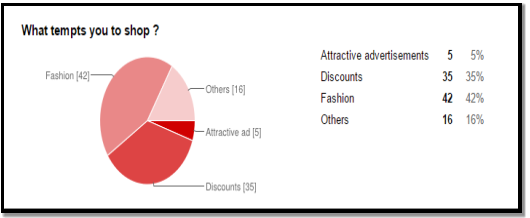 Graph 3
Graph 3
When shopping, what do you look for?
 Value for money
Value for money
 Good Quality
Good Quality
 Customer service
Customer service
 Product image
Product image
 Others
Others
 Graph 4
Graph 4
Do you prefer brands?
Yes
No
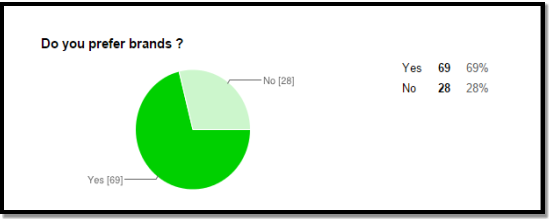 Graph 5
Graph 5
If yes, which brand? (Clothing brand)
If yes, which brand? Ornament brand (Jewellery)
Where do you prefer to shop?
 Online
Online
 Shopping Malls
Shopping Malls
 Market
Market
 Exhibitions
Exhibitions
 Others
Others
 Graph 6
Graph 6
Why do you usually shop for Ornaments?
 For Festive Reasons
For Festive Reasons
 For Occasions (Weddings, Birthdays)
For Occasions (Weddings, Birthdays)
 For Gifting Purpose
For Gifting Purpose
 For Investments Purpose
For Investments Purpose
 For Re-sale Values
For Re-sale Values
 For Daily Wear
For Daily Wear
 Graph 7
Graph 7
The Population Regression Function for Clothing is given by:
Yi = β1 + β2X1i + β3X2i + β4X3i + β5X4i + β6X5i + β7 X6i + β8 X7i +Ui
Where Yi is the dependent or the explained variable, the X’s are the independent or explanatory variables and Ui is the error term.
Yi = Consumption Demand
X1i = Age
X2i = Shopping Intensity
X3i = Shopping Frequency
X4i = Shopping Temptation
X5i = Shopping Requirements
X6i = Shopping Brands
X7i = Shopping Place
β1= Constant
β2= Coefficient of Shopping Intensity
β3 = Coefficient of Shopping Frequency
β4 = Coefficient of Shopping Temptation
β5 = Coefficient of Shopping Requirements
β6 = Coefficient of Shopping Brands
β7 = Coefficient of Shopping Place
We have taken the period 1980-2011 for conducting our study
Null Hypothesis: To test β1 = β2 = β3 = β4 = β5 = β6 = β7 = β8 = 0
Alternative Hypothesis: β1 = β2 = β3 = β4 = β5 = β6 = β7 = β8 ≠ 0
After we run an OLS (Ordinary Least Squares) on the available data we get the following results as shown in Table 1.
 Table 1
Table 1
Interpretation
OLS regression analysis was employed to show the relative influences of variables like age, shopping intensity, shopping frequency, shopping temptation, shopping requirements, shopping brands, shopping place on consumer buying behavior of clothes in the state of Pune.
The results indicates that when there is a rise in age by 1 unit, the Consumer demand rises by 0..47 units
The result indicates that when there is a rise in shopping intensity by 1 unit, the Consumer demand falls by 4.76 units.
The result indicates that when there is a rise in shopping frequency by 1 unit, the Consumer demand rises by 3.56 units.
The result indicates that when there is a rise in shopping temptation by 1 unit, the Consumer demand rises by 0.963 units.
The result indicates that when there is a rise in shopping requirements by 1 unit, the Consumer demand rises by 1.467 units.
The result indicates that when there is a rise in shopping brands by 1 unit, the Consumer demand falls by 46.15 units.
The result indicates that when there is a rise in shopping place by 1 unit, the Consumer demand falls by 1.724 units.
From the survey and the noted results through the pie charts we can make the following interpretation on the buying behaviour of the consumers:-
Shopping intensity shows a negative coefficient influence whereas shopping frequency shows a positive coefficient influence.
Income of consumers have the most influences on consumer buying decision process due to the fact that low income earners may want to prioritize their spending to satisfy basic needs and high income earners concentrate more on their taste and preferences. As a result we see a negative coefficient influence with the consumer buying demand and the place of shopping. Consumers with higher income tend to choose places with brands and luxurious commodities as compared to people with lower income, who would choose to maximize their utility of consumption by minimizing the cost. Hence they may prefer to choose places where non-branded clothes are available too.
Shopping temptation and requirements have a positive coefficient influence thus stating that when people are tempted by advertisements, their demand for consumption rises. Consumers shop according to their requirements which are a major factor determining consumer’s propensity to spend and the lower it is the higher the need to carefully share it among basic needs.
Shopping brands seem to have a negative coefficient influence on the consumer demands proving that people prefer quality of product more than the brand name associated with it.
Age was found to have great impacts on purchasing choice process as uncovered by the positive relapse coefficient impacts over the purchasing choice stages. This may most likely be because of our propensities to learn and adjust to methods for the general public as we go through our lifecycle stages, and especially on account of physical advancement, which influence the kind garments we purchase.
Since we have cross Sectional data, there might be a presence of heteroscedaticity. In order to cure heteroscedasticity, we use the General White’s test and see the following result:-
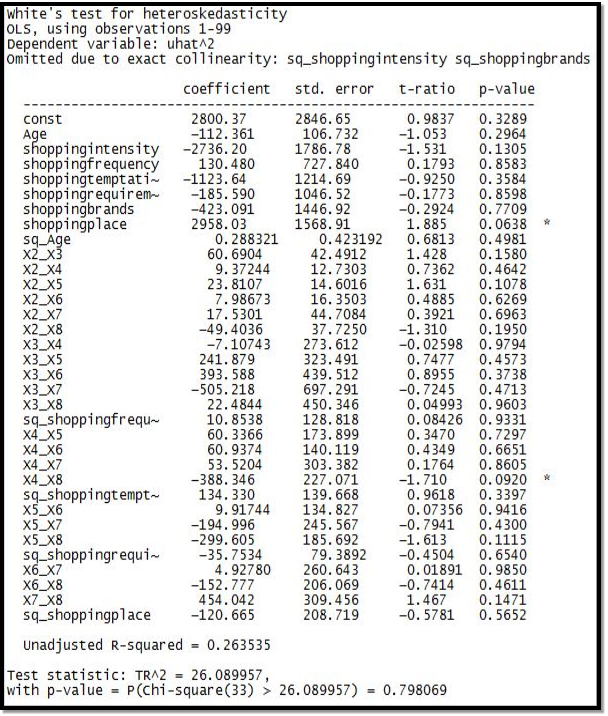
We take the null of homoscedasticity.
The higher the P-Value, more we do not reject the null of homoscedasticity.
In order to carry on with the research, we need a more fitted model .

Graph 8
Fit of all the variables with Consumer Demand
From the above graphs we see how well the consumer demand fits with the independent variables like age, shopping intensity, shopping frequency, shopping temptation, shopping brands, shopping requirements and shopping place.
After we run an Chi-Square test on the available data on Ornaments (Jewellery) we get the following results as shown in Table 2, 3 and 4.
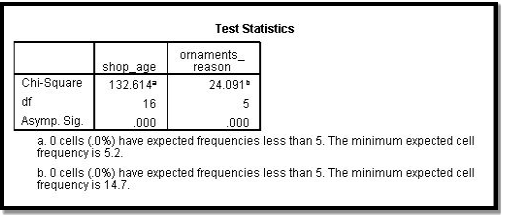 Table 2
Table 2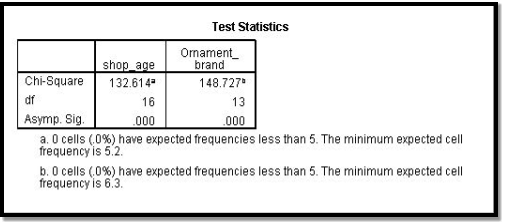 Table 3
Table 3 Table 4
Table 4
The study investigated that there is significance between consumer’s age and their choice of brands related to ornaments. We compute a chi-square test. The graphs and the Chi-Square test help us obtain an insight into the consumer’s behavior towards purchasing ornaments. The purchase can be made with respect to festivities, investment, marriages or gifts. The research shows that both male and female gender buys ornaments. We can thus conclude that female gender shows attraction towards jewellery mainly because of consumption but male gender purchases it for investment. Maximum female consumers are interested in the purchase of ornaments. The purpose/reason for purchase varies from consumer to consumer.
Conclusion
This examination adds to the comprehension of buyer purchasing conduct in the attire and adornment market. The significant discoveries of the study demonstrated that the general arrangement of autonomous/independent variables was weekly connected with the dependent variable. These examinations make it conceivable to find consumer choice making guidelines. The climbing economy has made Indian purchasers more wealthy. This study has concentrated on how the purchasing conduct of customers differs.
In light of this study, we presumed that, individuals in Pune city have relevant learning about various brands of the Clothes and adornments. Information about garments and adornments vary in light of the age level. The demographic components like age, sexual orientation i.e., gender, capability, frequency and so on segregating the purchasing conduct of Clothes and Ornaments is in view of this study the mindfulness level of purchasers. The majority of the respondents have the important learning on the famous brands. Respondents are very little partial by retailer’s data.
The criticalness of adornments in the nation is obvious from the way that on numerous promising events, jewellery forms a piece of blessings. Jewellery has not just been considered with the end goal of adoration, additionally as a security in times of contingency. This is on the grounds that it is regularly extravagant and can be sold at whatever point there is a critical need of cash. Thusly, jewellery additionally fill the need of protection, which can be relied on. Because of the hugeness gold holds in India, the Indians purchase gold much of the time for weddings, as well as on their adoring occasions. Buyer’s state of mind, attitude and conduct on adornments purchase in Pune City has assumed a huge role.
References
- www.insikapub.com/Vol-01/No-03/07IJBAS(1)(3).pdf
- worldwidescience.org/topicpages/c/consumer+buying+behaviour.html
- mailer.oalib.net/paper/2690805
- www.technopak.com/files/Indian_Apparel_Market.pdf
- www.citiindia.com/pdf/Harminder%20Sahni.pdf
- www.cmu.edu/diertrich/sde/docs/lowenstein/behavioraleconomics.pdf
- scholarship.law.cornell.edu/cgi/viewcontent.cgi
- nowandfuture.com/d2/behavioraleconomicsribe239.pdf
- www.eia.gov/analysis/studies/demand/economicbehavior/pdf/appendixa.pdf
- www.nber.org/papers/w7948.pdf
- Ncbi.nlm.nih.gov/plumed/16813142
BOOKS
- Handbook of Centerport Behavioral Economics, By Morris Altman
- Behavioral Economic comes of age, By Princeton University
________________________________________________________
Cite This Work
To export a reference to this article please select a referencing stye below:
Related Services
View allDMCA / Removal Request
If you are the original writer of this essay and no longer wish to have your work published on UKEssays.com then please click the following link to email our support team:
Request essay removal


